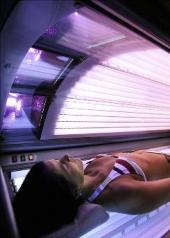Link between tanning beds, melanoma grows stronger
May 27, 2010
USA Today
Strong evidence now links tanning beds to melanoma, a deadly form of skin cancer that afflicts nearly 69,000 Americans a year.
People who have ever used tanning machines were 74% more likely to develop melanoma than others, according to a study of 2,268 patients reported today in Cancer Epidemiology, Biomarkers & Prevention.
Those who tanned the most — for 10 years or more — had more than twice the risk of melanoma compared with people who never used tanning beds, says co-author Martin Weinstock of Brown University School of Medicine. Those risks didn’t change when researchers accounted for age, sex, income, family history, education, skin and eye color, freckles, moles, sunscreen use or time in the sun.
About 2.5% of men and 1.7% of women develop melanoma, according to the American Cancer Society.
The study provides some of the strongest evidence yet to link tanning beds to melanoma, which kills nearly 7,000 Americans a year, says Electra Paskett of Ohio State University.
The study includes information on the newest tanning technologies, finding that machines emitting both types of ultraviolet light — UVA and UVB — increased melanoma risk, says Allan Halpern of New York’s Memorial Sloan-Kettering Cancer Center.
Halpern and many other doctors say they’re especially concerned about the risks of tanning salons for teenagers, which are popular this time of year as kids prepare for proms, graduations and beach trips. About 35% of 17-year-old girls use tanning machines, according to the Food and Drug Administration.
The new report comes at a time of increased scrutiny of indoor tanning:
•The FDA is considering recommendations from an advisory panel that suggested that teens be barred from tanning salons, or at least get parental consent before tanning.
•Congress included a 10% tax on indoor tanning in the health reform bill to help pay for expanding medical coverage and to make it harder for teens to afford indoor tanning.
•The International Agency for Research on Cancer, part of the World Health Organization, in July listed ultraviolet radiation-emitting beds as “carcinogenic to humans,” its highest category of cancer risk.
In a statement, the Indoor Tanning Association’s John Overstreet says scientists disagree about the link between melanoma and tanning beds. “When reputable researchers are coming to vastly different conclusions, it’s clear that a lot more research is needed,” he says. “The science on both sides of the question needs to be weighed before consideration is given to any sweeping policy changes.”
